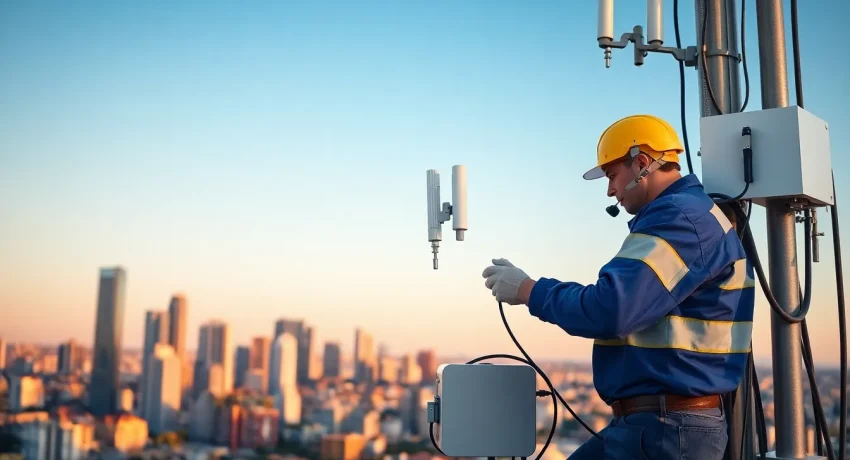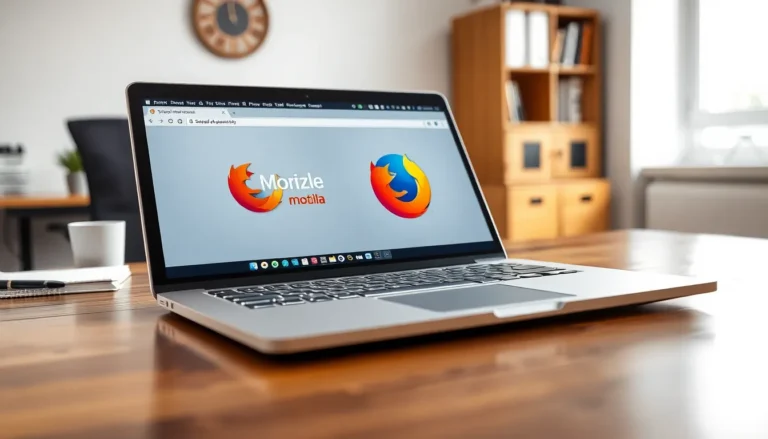Table of Contents
ToggleThe 5G network rollout is like the superhero of technology, swooping in to save the day with lightning-fast speeds and ultra-reliable connections. Gone are the days of buffering videos and dropped calls. With 5G, users can stream, game, and video chat without the dreaded “loading” symbol ruining the fun. It’s like upgrading from a bicycle to a rocket ship—who wouldn’t want that?
Overview of 5G Network Rollout
5G networks significantly enhance mobile connectivity with increased speeds and lower latency. Countries worldwide are swiftly implementing 5G technology, addressing the growing demand for faster and more reliable internet connections. Key players like Verizon, AT&T, and T-Mobile lead the 5G rollout in the United States, ensuring large urban areas receive coverage first.
Numerous benefits accompany the transition to 5G networks. Seamless video streaming, instant downloads, and lag-free gaming experiences become a reality, addressing common frustrations faced by users. Enhanced capabilities support the proliferation of smart devices, from connected cars to smart home appliances, increasing the demand for 5G connectivity.
Deployment efforts vary regionally. Urban zones typically see faster implementations due to higher population density. Conversely, rural areas often experience delays in access, which can hinder digital equality. Governments and telecommunication companies are working together to bridge this gap and ensure comprehensive coverage for all users.
Investment in infrastructure plays a crucial role in successful 5G rollout. Each network provider spends billions on upgrading existing towers and installing new base stations. This investment fosters a competitive environment, encouraging innovation and improvement in services.
5G networks promise a leap forward in connectivity, reshaping how people communicate, work, and interact. With ongoing efforts to expand coverage, the potential of 5G technology continues to unfold, paving the way for future advancements across various sectors.
Key Features of 5G Technology
5G technology introduces several key features that significantly enhance digital experiences. The increased speeds and reduced latency stand out prominently among these enhancements.
Faster Speeds and Reduced Latency
5G networks deliver download speeds up to 20 Gbps, making it crucial for applications requiring high data transfer rates. Users benefit from almost instantaneous content delivery, improving streaming and gaming experiences. Latency drops to as low as 1 millisecond, greatly enhancing real-time interactions. Such improvements benefit applications that depend on quick response times like augmented reality and virtual reality. With this much faster performance, users seldom face interruptions, transforming everyday activities into seamless experiences.
Enhanced Connectivity
Enhanced connectivity defines 5G’s ability to support more devices simultaneously. The technology accommodates over a million devices per square kilometer, making it key for smart cities and the Internet of Things. Reliable connections rise significantly, allowing various devices to operate efficiently without interference. This capacity enables advanced applications in healthcare, automotive, and smart environmental controls. With substantial improvements in connectivity, users experience smoother operation of smart devices, paving the way for innovative solutions in everyday life.
Global 5G Network Rollout Status
The 5G network rollout is expanding rapidly across the globe. Countries are intensifying efforts to improve mobile connectivity and enhance user experience.
Leading Countries in 5G Deployment
South Korea, China, and the United States lead in 5G deployment, showcasing significant advancements in technology and infrastructure. South Korea, for instance, achieved nationwide coverage early, benefiting industries like gaming and entertainment. China follows closely, with over 700 million 5G users as of 2023, furthering its ambition to become a global tech leader. The United States, driven by major providers like Verizon and AT&T, focuses on large urban areas, achieving impressive download speeds and low latency. Emerging markets in regions like Europe, Southeast Asia, and the Middle East are also accelerating deployment, eager to boost their digital economies.
Challenges Faced by Different Regions
Rural areas struggle with slower deployment compared to urban centers, highlighting the digital divide. Limited investment in infrastructure often results in inconsistent coverage, leaving many underserved. Countries in Africa and parts of Latin America face similar challenges due to economic constraints and logistical issues. Regulatory hurdles further complicate the rollout, as governments navigate spectrum allocation and competition. Snowballing demand for internet access, particularly during the pandemic, puts pressure on carriers to accelerate installation of new technologies. Solutions require collaboration among governments and private sectors to ensure comprehensive access and overcome existing obstacles.
Impact of 5G on Industries
5G technology significantly influences various industries, transforming operations and improving efficiency. The enhanced speed and low latency of 5G create numerous opportunities for growth across sectors.
Telecommunications and Beyond
Telecommunications companies experience the most immediate impact. With 5G, they provide faster internet services, improving customer experiences. Enhanced connectivity allows for clearer voice calls and uninterrupted video streaming. Other sectors, including manufacturing and entertainment, also benefit from these advances. Manufacturers adopt IoT devices for real-time monitoring, increasing productivity and reducing costs. Entertainment providers offer high-definition content instantly, catering to demands for seamless viewing experiences.
Potential for Smart Cities
Smart cities rely heavily on 5G networks to operate efficiently. High-speed connectivity supports integrated systems for traffic flow, public safety, and utility management. Smart traffic lights adjust in real-time, reducing congestion and improving urban mobility. Public safety applications utilize real-time data for effective emergency response. Utility systems monitor energy consumption, enabling better resource management. Thus, 5G paves the way for sustainable urban environments, fostering innovation and improving residents’ quality of life.
Future Outlook for 5G Network Rollout
Emerging trends in 5G technology indicate significant advancements ahead. Collaborations among telecommunications companies, governments, and technology firms will likely enhance infrastructure development. Innovations in smart devices will require robust 5G networks, directly influencing technology adoption rates.
Projected growth in global 5G connections supports the integration of more devices into the Internet of Things. By 2025, experts predict over 1.7 billion global 5G users, highlighting the demand for faster connectivity. New applications in sectors like healthcare and transportation will significantly benefit from 5G’s reliability and speed.
Investment in research and development will play a crucial role in advancing 5G capabilities. Enhanced data analytics will emerge as a key area, enabling better network management and user experiences. This focus on optimization will ensure telecommunication providers meet the growing demands for high-speed connections.
Expect rural 5G deployment to gain momentum as governments and companies address digital disparities. Initiatives aimed at increasing accessibility will promote equality in the digital landscape. Urban areas can serve as model environments for rural 5G expansion, utilizing successful strategies.
Regulatory frameworks will evolve to support 5G growth, providing clearer guidelines for deployment. Strengthened policies will pave the way for smoother collaborations between public and private sectors. Overall, the future of 5G rollout appears promising, with transformative impacts across various industries.
Conclusion
The rollout of 5G networks is set to revolutionize the digital landscape. With its unparalleled speed and low latency, it enhances everyday experiences, enabling seamless communication and advanced applications. As countries strive for comprehensive coverage, the collaboration between governments and telecommunications is vital for bridging the digital divide.
The future looks bright as industries leverage 5G technology to innovate and improve efficiency. From smart cities to enhanced entertainment, the potential is immense. As investment in infrastructure continues, the promise of 5G will reshape how people interact with technology and each other, paving the way for a more connected world.





